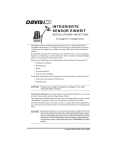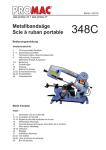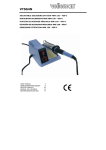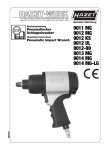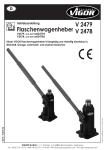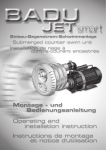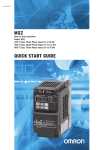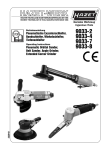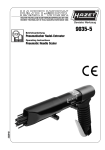Download V4226 Mobiler Spannbock
Transcript
Anwendungshinweis Einspannbereich: 0 - 913 mm Mobiler Spannbock Achtung Lesen Sie alle Anweisungen Nicht auf das Produkt klettern 300 kg Max. Gewicht Nicht die Finger klemmen Vor Nässe schützen V4226 Max. Einspanndruck: 1000 kg 300 kg Max.Traglast: 300 kg Vorbereitung zur Anwendung: Drehen Sie den Spannbock um, so dass die Beine sich nach oben öffnen können. 1. Lösen Sie die Verriegelungsschraube für das Hinterbein, damit das Hinterbein positioniert werden kann. 2. Schieben Sie das Hinterbein aus seinem Aufbewahrungsfach heraus. 3. Drehen Sie das Bein nach oben. 4. Achten Sie darauf, dass das Hinterbein in seine Verriegelungstasche geschoben wird. 5. Ziehen Sie die Verriegelungsschraube für das Hinterbein fest an. 6. Drehen Sie jedes Vorderbein, bis es vollständig geöffnet ist; ein Federriegel aus Metall sorgt dafür, dass jedes Bein in vollständig geöffneter Position verriegelt wird. 7. Kontrollieren Sie, ob die Riegel an beiden Beinen vollflächig am den Frontrahmen einrasten und die Beine sicher verriegelt sind. Diese Riegel können durch Verschieben des grünen Riegels entlang des Beines betätigt werden. 8. Öffnen Sie den Fußhebel, indem Sie ihn wie abgebildet drehen. Der Fußhebel wird mit einem Metallriegel sicher verriegelt. Dieser Riegel wird durch Verschieben einer Metallöse an der Rückseite des Fußhebels betätigt. 9. Prüfen Sie, ob alle Riegel eingerastet und Verriegelungsschrauben fest angezogen und die Beine sicher verriegelt sind. 10. Drehen Sie den Spannbock herum, und stellen Sie ihn auf seine Beine, indem Sie das Hinterbein festhalten und ihn so herumdrehen, dass er auf seinen beiden Vorderbeinen steht, und dann das Hinterbein darüber heben und auf den Boden stellen. V4226 AH Verpackung Reinigen Sie den Spannbock gemäß der Wartungsanleitung im folgenden Abschnitt. Führen Sie die obigen Anweisungen in umgekehrter Reihenfolge aus: Drehen Sie den Spannbock auf den Kopf, entriegeln Sie den Fußhebel und klappen Sie ihn ein, entriegeln Sie beide Vorderbeine und klappen Sie diese ein, lösen Sie das Hinterbein und klappen Sie es ein, dann schieben Sie es in sein Aufbewahrungsfach, bevor Sie die Verriegelungsschraube anziehen. In dieser Position kann das Hinterbein als Tragegriff verwendet werden. Einspannmethode: Fußpedal Bedienung: Verriegelung 1. Positionieren Sie das Werkstück an der feststehenden Seite der Spannbacke. 2. Schieben Sie das bewegliche Teil der Spannbacke mit der Hand oder durch Betätigung des Fußhebels gegen das Werkstück. 3. Schieben Sie den Verriegelungsschalter nach unten in die Verriegelungsstellung. 4. Drücken Sie den Fußhebel schrittweise herunter, um die Spannbacke weiter zu spannen. Entriegelung 1. Sichern Sie das Werkstück, so dass es nicht herunterfällt, wenn die Spannbacke sich öffnet. 2. Schieben Sie den Verriegelungsschalter nach oben in die Entriegelungsposition. 3. Drücken Sie den Fußhebel zum Lösen der Knarre, dabei ist ein Klicken hörbar. 4. Schieben Sie die Spannbacke vom Werkstück weg. Einstellung der Spannbacke für große oder kleine Werkstücke 1. Schieben Sie den Verriegelungsschalter nach oben in die Entriegelungsposition, und drücken Sie den Fußhebel zum Lösen der Knarre. 2. Halten Sie das bewegliche Teil der Spannbacke fest, und schieben Sie es weg von der feststehenden Spannbacke. 3. Nehmen Sie die bewegliche Spannbacke vollständig aus dem Spannbock heraus, und drehen Sie sie herum. 4. Richten Sie die bewegliche Spannbacke am Ende des Spannbocks aus, und verschieben Sie sie so lange, bis sie die Sperrstifte abdeckt. Nehmen Sie die Spannbacke ganz heraus, und drehen Sie sie herum, um den Spannbereich zu vergrößern. ViGOR GmbH • ; Am Langen Siepen 13-15 • 42857 Remscheid • GERMANY [ +49 (0) 21 91 / 97 95 • \ +49 (0) 21 91 / 97 96 00 • ^ vigor-equipment.com • ] [email protected] Sicherheitshinweise und Sicherheitsmaßnahmen: Das Gerät ist zum Zeitpunkt seiner Entwicklung und Fertigung nach geltenden, anerkannten Regeln der Technik gebaut und gilt als betriebssicher. Es können vom Gerät jedoch Gefahren ausgehen, wenn es von nicht fachgerecht ausgebildetem Personal, unsachgemäß oder nicht bestimmungsgemäß, verwendet wird. Jede Person, die mit Arbeiten am oder mit dem Gerät beauftragt ist, muss daher die Betriebsanleitung vor Beginn der Arbeiten gelesen und verstanden haben. Für Verletzungen und Schäden, die aus unsachgemäßer, zweckentfremdeter und nicht bestimmungsgemäßer Anwendung bzw. Zuwiderhandlung gegen die Sicherheitsvorschriften resultieren, übernimmt VIGOR keine Haftung oder Gewährleistung. Die Betriebssicherheit ist nur bei bestimmungsgemäßer Verwendung entsprechend der Angaben in der Betriebsanleitung gewährleistet. Neben den Arbeitssicherheits-Hinweisen in dieser Betriebsanleitung sind die für den Einsatzbereich des Gerätes allgemein gültigen Sicherheits-, Unfallverhütungs- und Umweltschutz-Vorschriften zu beachten und einzuhalten. Die Benutzung und Wartung von Werkzeugen muss immer entsprechend den lokalen staatlichen Landes- oder Bundesbestimmungen erfolgen. Gerät nur in technisch einwandfreiem und betriebssicherem Zustand betreiben. Sicherheitseinrichtungen immer frei erreichbar vorhalten und regelmäßig prüfen. Die Funktion des Mobilen-Spannbockes ist das Klemmen und Festhalten von Werkstücken. Jede über die bestimmungsgemäße Verwendung hinausgehende und/oder andersartige Verwendung des Gerätes ist untersagt und gilt als nicht bestimmungsgemäß. Ansprüche jeglicher Art gegen den Hersteller und/ oder seine Bevollmächtigten wegen Schäden aus nicht bestimmungsgemäßer Verwendung des Gerätes sind ausgeschlossen. Für alle Schäden bei nicht bestimmungsgemäßer Verwendung haftet allein der Betreiber. Vor jeder Benutzung ist der Mobile-Spannbock auf seine volle Funktionsfähigkeit zu prüfen. Ist die Funktionsfähigkeit nach dem Ergebnis dieser Prüfung nicht gewährleistet oder werden Schäden festgestellt, darf das Gerät nicht verwendet werden. Ist die volle Funktionsfähigkeit nicht gegeben und das Gerät wird dennoch verwendet, besteht die Gefahr von erheblichen Körper-, Gesundheits- und Sachschäden. Volle Funktionsfähigkeit ist gegeben, wenn: - das Gerät leichtgängig ist - das Gerät keine Beschädigung aufweist. Verwenden Sie das Gerät nicht im Regen oder in einem feuchten Bereich. Die Einzelteile dürfen nur in der vorgesehenen Zusammenstellung eingesetzt werden. Bei der Arbeit mit dem Mobilen-Spannbock ist auf Schutzbrille und enganliegende Arbeits-Schutzkleidung zu achten. Alle Service- oder Reparaturarbeiten immer durch Fachpersonal ausführen lassen. Um die Betriebssicherheit auf Dauer zu gewährleisten, dürfen nur Originalersatzteile verwendet werden. Aus Sicherheitsgründen sind Veränderungen am Mobilen-Spannbock strengstens untersagt. Die Vornahme von Veränderungen am Mobilen-Spannbock führt zum sofortigen Haftungsausschluss. Wartung: Allgemeine Überprüfung Kontrollieren Sie regelmäßig, ob alle Kabel und Teile vorhanden und in Ordnung sind. Jede Beschädigung erhöht das Risiko für Personen- und Sachschäden. Reinigung Entfernen Sie sämtlichen Schmutz mit einem Lappen und etwas Leichtöl, achten Sie auf Feuchtigkeits- oder Korrosionsbildung an Metallteilen. ACHTUNG Verwenden Sie keine Reinigungsmittel zum Reinigen der Plastikoder Kunststoffteile an diesem Produkt. Etwas milde Seifenlauge auf einem feuchten Tuch wird empfohlen. Schmierung Bewegliche Teile und Federn sollten eine dünne Oberflächenschicht aus Öl oder Fett zur Unterstützung ihrer Funktion und Ver- 2 meidung von Korrosion aufweisen. Besondere Aufmerksamkeit sollte den Klemmen gewidmet werden, durch welche die Beine und der Fußhebel in ihrer geöffneten Position verriegelt werden. Rostschutz Unlackiertes Metall kann rosten, wenn es der Luft ausgesetzt ist. Sorgen Sie dafür, dass unlackiertes Metall stets gut geschmiert ist, und bessern Sie Kratzer auf lackierten Oberflächen mit einem geeigneten Lack aus. Oberflächenrost sollte vor dem Neulackieren mechanisch entfernt werden. Bewahren Sie das Produkt, die Bedienungsanleitung und das Zubehör an einem sicheren, trockenen Ort auf. So haben Sie sämtliche Informationen und Teile stets griffbereit. Dieses Produkt beinhaltet keine vom Benutzer zu wartenden Teile. Reparaturen sollten ausschließlich durch eine zugelassene Reparaturwerkstatt durchgeführt werden. Technische Daten: Produktcode ........................................ Spannkraft ........................................... Maximale symmetrische Belastung .. Spannbackenverlängerung ............. Produktabmessungen ....................... .............................................................. Gewicht ............................................... V4226 1.000 kg (2200 Pfund) 300 kg (661 Pfund) 913 mm (36 Zoll) 870 x 970 x 870 mm ca. (34 x 38 x 34 Zoll) 21,0 kg (48,5 Pfund) Häufig gestellte Fragen (FAQ): Ich kann nichts einspannen, was mache ich falsch? Die Spannbacken werden mit dem Fußhebel zusammen verriegelt, wenn der Verriegelungsschalter in der Entriegelungsposition ist; zum Spannen der Spannbacke müssen Sie in die Verriegelungsposition schalten und dann den Fußhebel betätigen. Die Spannbacken halten mein Werkstück nicht sicher fest, was kann ich tun? Stellen Sie sicher, dass der Spannbock korrekt bedient wird. Prüfen Sie, ob die Spannbacken fett- und schmutzfrei sind, und reinigen Sie sie bei Bedarf. Prüfen Sie, ob sich ein ausreichender Teil des Werkstücks zwischen den Spannbacken befindet, damit das Werkstück ordnungsgemäß gehalten werden kann. Bestimmte Formen sind möglicherweise nicht geeignet, um direkt zwischen den Spannbacken eingespannt zu werden, in diesem Fall können Sie das Objekt einspannen, indem Sie zuerst eine Form schaffen, die das Objekt sicher halten kann, und dann die neue Form zwischen den Spannbacken einspannen. Ich kann die Spannbacken nicht entriegeln, was kann ich tun? WARNUNG! Vorsicht: Beim Entriegeln der Backen kann es zu einem Rückschlag durch sämtliche Teile sowie durch Ihr Werkstück kommen. Die gleiche Kraft, die zum Schließen der Spannbacken erforderlich ist, ist auch zum Entriegeln der Spannbacken erforderlich. Stellen Sie sicher, dass der Schalter in der Entriegelungsposition ist, dann üben Sie Druck auf den Fußhebel aus, bis Sie ein Klicken hören, wenn die Knarre gelöst wird. Dann sollten Sie in der Lage sein, die Spannbacken auseinander zu schieben. Lassen sich Ihre Spannbacken gar nicht lösen, verwenden Sie folgende Methode als letztes Mittel. Der Fußhebel wird sicher verriegelt durch einen Metallgleitstab, der durch die Öffnung in einem Gleitblech verläuft, das heißt es steht senkrecht zum Metallgleitstab, dadurch wird die Knarre gelöst. Wie kann ich meinen Spannbock reparieren lassen, wenn er beschädigt ist, und wo erhalte ich Zubehör, Ersatzteile, Ratschläge oder Unterstützung? Kontaktieren Sie Ihren Händler, oder besuchen Sie uns im Internet auf www.vigor-equipment.com V4226 Application Note Mobile clamping block Clamp Extension: 0 - 913 mm Take Care Read All Instructions Do Not Climb On 300 kg Max Weight Beware of Trapped Fingers Keep Dry 300 kg Max. Clamping Force: 1000 kg Max.Weight: 300 kg Prepare for use: Prepare for use Turn the mobile clamping block over so that the legs can open upwards. 1. Loosen the rear leg locking screw by a few turns to allow the rear leg to be positioned. 2. Slide the rear leg out of its storage pocket. 3. Rotate the leg upward. 4. Ensure the rear leg is pushed into the locking pocket. 5. Tighten rear leg locking screw. 6. Rotate each front leg all the way open, there is a spring loaded metal catch that will lock each leg in place when fully open. 7. Check the catches on both legs have locked over the front frame and secured the legs in place. These catches can be operated by sliding the green catch along the leg. 8. Open the foot lever by rotating it as shown. The foot lever is locked in place with a metal catch. This catch is operated by sliding a metal loop in the rear of the foot lever. 9. Check all catches and locking screws are tightened and legs locked in place. 10. Turn the mobile clamping block onto its legs by holding the rear leg and rotating it onto its two front legs then lifting the rear leg over and onto the floor. Packing Clean as per maintenance directions in following section. Reserve the above directions: turn upside down, unlock and fold foot lever, unlock and fold both front legs, loosen, lift and fold the rear leg then slide into its storage pocket before tighttening the locking screw. In this position this rear leg can be used as a carry handle. Clamp method: foot lever Operation: Locking 1. Position the workpiece against the fixed side of the clamp. 2. Move the sliding part of the clamp against the workpiece by hand or by operating the foot lever. 3. Slide the locking switch down into the Locked Position. 4. Press the foot lever gradually to further tension the clamp. Unlocking 1. Secure the workpiece so it does not drop when the damp opens. 2. Slide the locking switch up into the Unlocked Position. 3. Press the foot lever to unlock the ratchet, you will hear a click as this happens. 4. Slide the clamp away from the workpiece. Setting clamp for Large or Small items 1. Slide the locking switch up into the Unlocked Position and press the foot lever to release the ratchet. 2. Firmly hold the sliding clamp part and slide it away from the fixed clamp. 3. Completely remove the sliding clamp from the mobile clamping block and turn it around. 4. Align the sliding clamp with the end of the mobile clamping block and slide it along until it covers the ratchet pins. Completely remove clamp and turn around to extend clamp range. 3 Safety Notes for use: This tool was developed and manufactured according to the technical norms and standards valid at the time and is considered to be operationally reliable. Nevertheless, the tool set can present a danger when it is not used as intended or is used inappropriately by non-qualified personnel. Please make sure that any person using this tool or carrying out maintenance work carefully reads these operating instructions and fully understands all provided information before using the tool. VIGOR will not be liable for any injuries to persons or damage to property originating from improper use, misuse or inappropriate use of the tool, or from a disregard of the safety instructions. Operational reliability can only be ensured if the tool set is used as intended and in compliance with the information provided in the operating instructions. In addition to the safety advice in these operating instructions, the general safety regulations, regulations for the prevention of accidents, and regulations for environmental protection for the application area of this tool set have to be observed and respected. Always ensure tools are used, inspected and maintained in compliance with the appropriate local, state, national or federal regulations. The tool set may only be used if it is in good working order. All safety equipment must always be within reach and should be checked regularly. The Mobile- lamping Block is used for clamping and holding of work pieces. Any deviation from the intended use and/or any misapplication of the tool set is not allowed and will be considered as improper use. Any claims against the manufacturer and/or its authorized agents because of damage caused by improper use of the tool set are invalid. Any personal injury or material losses caused by improper use of the tool are the sole responsibility of the owner. Before each use, check the Mobile-Clamping Block for correct and full functionality. Do not use the Mobile-Clamping Block if correct functionality cannot be ensured or if damage is detected. If the Mobile-Clamping Block is used when not in full working order, you risk severe personal injury as well as damage to health and property. The device is fully functional when: - the device runs smoothly - the device shows no signs of damage. Don´t use the device in the rain or in a damp area. The individual parts may only be used in the foreseen combinations. When operating the Mobile-Clamping Block it is necessary to wear safety glasses and properly fitted protective clothing. All service or repair work must be carried out by qualified personnel only. In order to guarantee long-term operational safety, only original spare parts must be used. For safety reasons any modification of the Mobile-Clamping Block is strictly forbidden. Any modification of the Mobile-Clamping Block will result in immediate invalidation of the warranty and exclusion from liability. Maintenance: General inspection Regularly check that all wires and fittings are present and correct. Any damage increases risk to person and property. Rust prevention Unpainted metal can rust if exposed to the air. Keep unpainted metal lubricated and touch up scratches on painted surfaces with a suitable paint. Surface rust should be removed mechanically before repainting. Store the product, instruction manual and accessories in a secure, dry place. In this way you will always have all the information and parts ready to hand. This product contains no user serviceable parts. Repairs should only be carried out by a authorised rapairer. Technical Specifications: Product Code ..................................... Clamping Force ................................. Maximum Balanced Load ................ Clamp Extension ................................ Product Dimensions ........................... .............................................................. Weight ................................................. V4226 1.000 kg (2200 Ibs) 300 kg (661 Ibs) 913 mm (36“) 870 x 970 x 870 mm approx (34 x 38 x 34“) 21,0 kg (48,5 Ibs) Frequently Asked Questions (FAQ): I cant clamp anything what am I doing wrong? The jaws will ratchet along with the fool lever when the locking switch in unlocked, to tension the camp you need to switch to the locked position and then operate the foot lever. The jaws are not holding my work securely, what can I do? Ensure the Mobile clamping block is being correctly operated. Check that the jaws are free of grease and debris and clean as needed. Check that enough of the object is in the jaws to grip it properly. Cerlain shapes may not be suitable for clambing directly into the jaws, in this case you might be able to clamp the item by first creating a shape that will hold the item firmly and then clamping the new shape in the jaws. I cant unlock the jaws, what can I do? WARNING! Beware of kickback from all parts and your work piece as the clamp is unlocked. The same force used too close the clamp is required to unlock the clamp. Ensure the switch is in the unlocked position, then apply pressure to the foot lever until your hear a click as the ratchet disengages. You should then be able to slide the jaws appart. If your clamp will not unlock at all use the following method as a last resort only. The foot lever is locked in place by a sliding metal rod running through the hole in a pivoting plate so it is perpendicular to the sliding metal rod, this will release the ratchet. How can I get my mobile clamping block repaired if it is damaged and where can I get accessories, repacement parts, advice or help? Contact your retailer or visit www.vigor-equipment.com CAUTION Do not use cleaning agents to clean the plastic or rubber parts of this product. A mild detergent on a damp cloth is recommended. Lubrication Moving parts and springs should have a thin surface layer of oil or grease to aid their function and prevent corrision, Particular attention should be paid to the clips which hold the legs and foot lever locked in their open position. ViGOR GmbH • ; Am Langen Siepen 13-15 • 42857 Remscheid • GERMANY [ +49 (0) 21 91 / 97 95 • \ +49 (0) 21 91 / 97 96 00 • ^ vigor-equipment.com • ] [email protected] V4226 II. 01.2015/ ∞ Ho/330 Cleaning Remove all debris with a rag and some light oil, beware of buildup of damp or corrosive agents on metal parts.






